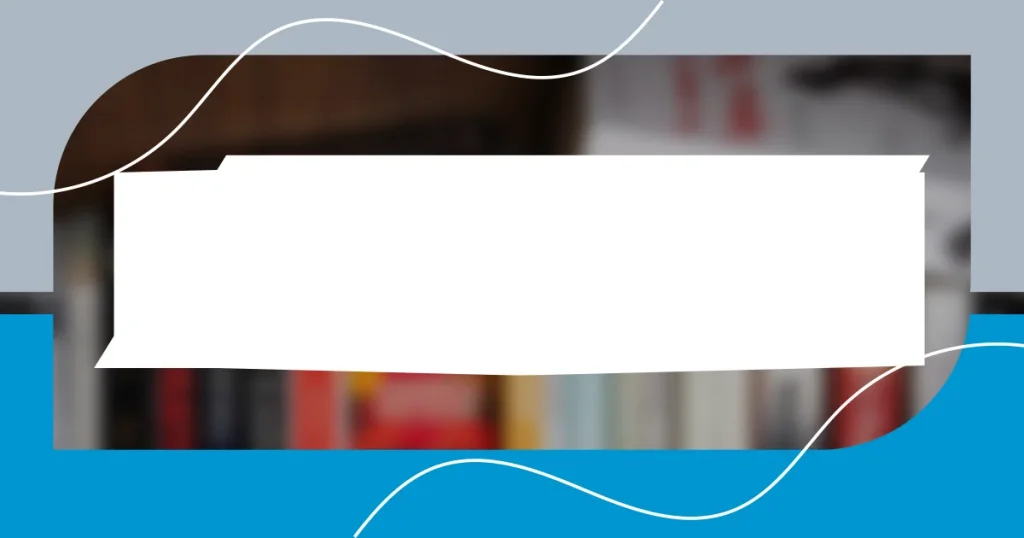Key takeaways:
- Writing serves as a profound medium for self-discovery and emotional exploration across various genres.
- Inspiration can be drawn from everyday experiences, interactions, and diverse sources such as nature, music, and personal memories.
- Building a diverse writing portfolio fosters creativity, encourages versatility, and enhances the development of a unique voice.

Understanding my writing journey
Understanding my writing journey has been a profound exploration of self-discovery. I remember the first time I put pen to paper—there was something magical about transforming my thoughts into words. Have you ever felt that thrill of creation? It’s an exhilarating dance between inspiration and intention.
Early on, I dabbled in poetry, captivated by its rhythm and imagery. I still vividly recall the soft rustle of paper as I wrote my first haiku, capturing a fleeting moment in nature. That experience taught me how writing could encapsulate emotions in just a few syllables. It makes me wonder, how many feelings can we truly express in brevity?
As I ventured into fiction, I found myself drawn to characters who mirrored my own struggles and triumphs. Creating their narratives felt like therapy, allowing me to navigate my thoughts freely. It makes me contemplate—does writing serve as a mirror for our own lives, reflecting back our innermost fears and dreams? For me, it certainly does.

Discovering inspiration sources
When I think about the sources of inspiration that spark my creativity, I often find myself reflecting on the people and experiences that surround me. Conversations with friends can ignite a story idea in a heartbeat, especially when they share relatable struggles or joyous moments. I recall one evening at a coffee shop, where a friend’s tale about overcoming adversity filled me with an urge to write. That blend of emotions became the foundation of my next character. It’s amazing how the simplest interactions can lead to profound creative insights.
Here are a few other sources of inspiration I’ve discovered along the way:
- Nature’s beauty, from quiet morning walks to vibrant sunsets, often inspires vivid imagery.
- Books and films that resonate can spark new ideas or help me see familiar themes from a different angle.
- Music has a unique way of evoking emotions and scenes in my mind, leading to unexpected plot twists.
- Personal memories—both joyful and painful—can provide rich material for character development and thematic depth.
- Even everyday life—from grocery shopping to waiting in line—can unveil stories waiting to be told.
These diverse sources keep my writing vibrant and grounded, reminding me that inspiration is everywhere if you’re open to it.

Exploring different writing genres
Exploring different writing genres has been like stepping into new worlds, each with its own set of rules and possibilities. For instance, when I first tried my hand at fantasy writing, I was entranced by the idea of crafting an entire universe filled with magic and adventure. I remember drafting my first map, pouring over every detail, and feeling my imagination truly roam free. Isn’t it captivating how a blank page can transform into something so vast?
Diving into non-fiction presented a contrasting experience. I’ve always felt a pull to share real stories—those that illuminate our humanity. One of my most memorable pieces was an article about an inspiring community project that brought neighbors together. The challenge of weaving facts with a narrative thread taught me that truth could be just as compelling as fiction. Can you believe that our real-life experiences can resonate deeply, too?
I find that writing poetry allows for a unique exploration of emotions. Each word is intentional, and I often feel a rush when I distill complex feelings into concise phrases. I recall writing about a turning point in my life when the weight of uncertainty felt too heavy to carry. That poem became not just a release but a way to connect with readers who might be navigating similar paths. Isn’t it remarkable how different genres can serve as vessels for varied expressions of self and connection?
| Genre | Key Characteristics |
|---|---|
| Fiction | Creative storytelling, character development, plot-driven narratives |
| Non-fiction | Fact-based writing, informative, emphasizes real events and experiences |
| Poetry | Emotional distillation, rhythmic structure, focus on imagery and conciseness |

Overcoming creative blocks
Creative blocks can feel daunting, and I’ve faced my fair share. I remember sitting at my desk, staring blankly at the screen, longing for words but feeling utterly paralyzed. It’s in those moments that I remind myself to step away—for me, a walk around the neighborhood can do wonders. The rhythm of my footsteps often opens up new pathways in my mind, allowing ideas to flow like a gentle stream. Have you ever noticed how a change of scenery can shift your perspective?
Another strategy I’ve found effective is journaling. When the creative wheels seem stuck, free-writing about my thoughts or feelings can untangle those frustrating knots. I once filled pages with the simplest musings about my day, only to uncover a hidden theme that sparked a short story. It’s surprising how expressing the mundane can lead to creative breakthroughs. Have you tried this method to kickstart your imagination?
Lastly, embracing imperfection has been liberating. I used to fear that my first drafts had to be polished, but now, I treat them as raw explorations. Last year, I penned an entire chapter that I thought would never see the light of day. To my surprise, it became a pivotal piece in my novel, full of rough edges that added depth and authenticity. Isn’t it fascinating how allowing ourselves to create messily can lead to unexpected gems?

Techniques for genre blending
Blending genres often begins with understanding the core elements of each genre involved. For example, I once experimented by merging elements of sci-fi and romance in a story about two star-crossed lovers from different planets. This blend not only heightened the emotional stakes but also allowed me to explore fascinating world-building opportunities. Have you ever thought about how combining genres could create fresh dimensions in your writing?
Another technique I find useful is creating characters that defy genre stereotypes. In a cozy mystery I wrote, my protagonist was a retired librarian who solved crimes using her love for historical fiction. This twist drew both mystery enthusiasts and book lovers into the narrative, showcasing how character development can bridge genre divides. Isn’t it exciting to think about how characters can breathe life into multiple genres at once?
Finally, I advocate for playing with narrative structure. I once penned a horror tale told through diary entries, blending suspense with personal reflection. This format provided a gripping immediacy while also revealing deeper emotional layers to the story. Have you considered how varying your narrative style can enhance your genre-blending efforts?

Building a diverse writing portfolio
Building a diverse writing portfolio has been one of the most invigorating aspects of my creative journey. I remember the first time I published a poem, a vulnerable piece that emerged from a moment of deep introspection. It was exhilarating to see my words resonate with others, and that experience encouraged me to explore short stories, essays, and even travel writing. Each genre I dipped my toes into opened my eyes to different facets of storytelling. Isn’t it fascinating how one small leap into a new form can inspire a wealth of ideas?
As I ventured into writing about various subjects, I discovered the importance of versatility. I found joy in writing about my travel experiences, but I also explored the intricacies of personal essays that allowed me to reflect on my identity. There were times when I felt like I was juggling too many genres, but that diversity helped me develop a unique voice. It’s almost like piecing together a mosaic—each genre adding a distinct tile to my overall artistic expression. Have you thought about how diversifying your writing could enhance your creative voice?
Ultimately, building a well-rounded portfolio demands both courage and curiosity. One of my proudest moments was embracing non-fiction after years of writing fiction. The day I wrote an article about the importance of mental health awareness, I wasn’t just documenting facts—I was pouring my heart into a message that mattered. That blend of personal and educational writing becomes its own force, impactful both for me as a creator and for those who read it. How do you think stepping beyond your comfort zone could transform your portfolio?

Staying motivated and productive
Staying motivated and productive often hinges on creating a routine that energizes my writing practice. I recall a period when I dedicated my mornings to writing, free from distractions. Focusing on my craft in those quiet hours became a sacred ritual, fueling my creativity and helping me produce a steady stream of work. Have you considered how a consistent writing schedule might help you harness your motivation?
Sometimes, the challenge of writer’s block creeps in, and I’ve learned to embrace it rather than fight it. I remember one afternoon when I simply could not get past a particularly tricky scene. Instead of staring hopelessly at the blank page, I went for a walk in nature, letting my thoughts drift. The fresh air and change of scenery reignited my inspiration, reinforcing that sometimes a break is exactly what I need to stay productive. What strategies do you use when creativity feels blocked?
Moreover, I find that surrounding myself with a supportive community boosts my motivation significantly. Joining a local writing group transformed my writing journey. Hearing others share their work, along with the honest feedback we exchanged, not only sparked new ideas but also kept me accountable. I truly believe that sharing our struggles and triumphs with fellow writers can invigorate our passions. How do you foster connections that inspire your writing efforts?
















